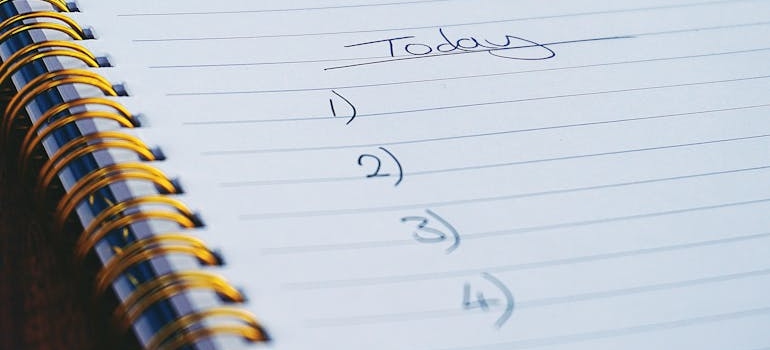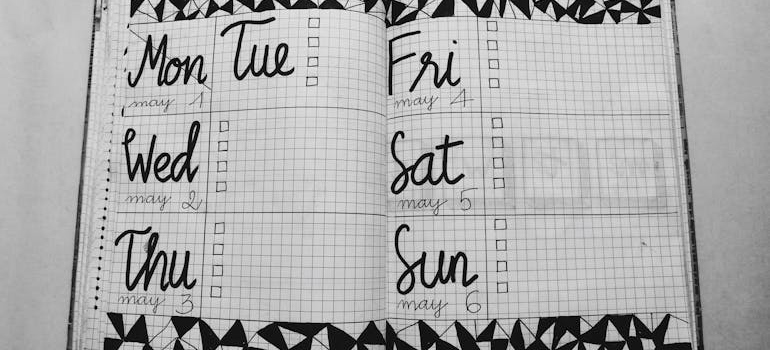Creating a Moving Checklist – How to Do It?
Creating a moving checklist simplifies the upheaval of relocating, offering a clear roadmap through the chaos. This tool works wonders for time management and stress reduction, meticulously organizing every move detail. A well-thought-out checklist ensures crucial tasks, such as coordinating with Idaho movers and managing the transfer of utilities, don’t fall through the cracks. It easily turns an overwhelming process into a series of achievable assignments by breaking down the move into manageable steps. Everything from packing to hiring Boise moving experts becomes a feasible task, solving the problem of where to start and how to proceed efficiently!
Why a Moving Checklist is Essential
A moving checklist is indispensable across various moving scenarios, each presenting its unique set of challenges. For those transitioning between apartments, it ensures that nothing is forgotten amidst tight spaces and building regulations. Homeowners benefit by tracking large-item handling and utility setups, making house moves smoother.
When moving out of state or cross-country, the complexity multiplies, necessitating meticulous planning for everything from legal requirements to long-haul logistics. Office and business relocations rely on checklists to minimize downtime and guarantee that operations resume swiftly in new locations.
Similarly, local and long-distance moves, though differing in scale, both demand organized action plans to manage time, resources, and the stress of change effectively. In essence, a moving checklist acts as a personalized guide, providing clarity, control, and peace of mind regardless of the moving distance or dwelling type.

Creating Your Ultimate Moving Checklist
A detailed moving checklist serves as the backbone of your relocation strategy. It is ensuring that every detail is accounted for, from the initial planning stages to the moment you settle into your new space. So, what should you begin with?
Task Organization
Start by laying a solid foundation for your checklist with comprehensive organization. Begin with broad categories such as packing, utilities, and movers, then drill down to specific tasks. Utilize digital tools or apps for real-time updates and reminders. Prioritize tasks based on urgency and time sensitivity and allocate deadlines to keep everything on track.
It would be wise to consider integrating a visual component, like a calendar or timeline, to map out your moving process visually. As you’re creating a moving checklist, you will also have to figure out what kind of moving services Boise ID you want from your movers. This methodical approach transforms overwhelming tasks into manageable actions, guiding you smoothly toward your move day.
Decluttering Process
This is your next critical step, offering a fresh start at your new location while simplifying your move. Tackle one room at a time, sorting items into keep, donate, sell, or discard. For homes, focus on reducing personal belongings and household items. Apartment dwellers should concentrate on maximizing space and minimizing excess.
In office settings, decluttering involves organizing documents digitally when possible and eliminating unnecessary equipment or furniture. This process lightens your load, reduces moving costs, and contributes to a more organized living or working environment.
Gathering Supplies
Efficiently sourcing high-quality moving supplies is essential for protecting your belongings. Research affordable options without compromising on quality. Consider reusing boxes from local businesses, obtaining them from discounted online marketplaces, or purchasing new quality supplies and moving boxes Boise providers offer. Keep an inventory of your supplies, including various sizes of boxes, packing tape, bubble wrap, and markers for labeling.

Remember to assess the specific packing needs based on item fragility and size to ensure you have all the necessary materials on hand. In other words, if you focus on organization, decluttering, and gathering supplies, you’ll create a moving checklist that’s a strategic plan for a successful and stress-free move.
Specialized Moving Checklists
Not two relocations are the same. Thus, the intricacies of moving require tailored strategies for different environments and distances. Therefore, specialized moving checklists offer a roadmap, ensuring a streamlined and efficient relocation process. And here’s how.
Apartment Moving Checklist
For apartment owners, space constraints and building rules necessitate a focused approach:
- Measure Spaces: Ensure your furniture fits in both your current and future apartments. Take measurements of doorways, elevators, and stairwells.
- Review Building Policies: Understand move-in/move-out times, elevator reservations, and any fees associated with moving.
- Packing Strategy: Utilize space-saving packing techniques, like vacuum-sealed bags for clothing and linens.
- Utility Coordination: Coordinate the transfer of utilities to avoid service gaps. Contact your service providers well in advance.
Bonus Tip: Engage with your future neighbors or building manager to gather insights on living in the building. They can offer valuable tips about amenities and community rules or even recommend local services like grocery stores or cafes. This information can help you adjust quickly to your new surroundings.
House Moving Checklist
Homeowners moving a house face a different set of challenges, often involving more substantial belongings and outdoor items:
- Inventory Outdoor Items: Don’t overlook outdoor furniture, grills, and garden tools. Determine what will move with you and prepare these items for transport.
- Plan for Large Items: Consider professional services for moving large or delicate items such as pianos or antiques.
- Change of Address: Update your address with all relevant parties and services, including banks, subscriptions, and government agencies.
- Safety and Repairs: Make your new home safe and comfortable by scheduling any necessary repairs or installations before moving day.
Bonus Tip: Conduct a final walk-through of your new home before moving day. This is the perfect time to take measurements, plan the placement of your furniture, and envision the space. Additionally, consider scheduling a deep clean of the house before your items arrive to start fresh in a spotless home.
Office/Business Moving Checklist
Business relocations require minimizing downtime and safeguarding data relying on an office moving checklist:
- Inventory and Tagging: Create a detailed inventory of office equipment and furniture. Tag items for tracking and organization.
- Data Backup: Ensure all company data is backed up and secure. Plan for the safe transport of sensitive files.
- Employee Coordination: Communicate moving plans with employees well in advance. Assign tasks or areas of responsibility to streamline the move.
- Service Transfers: Arrange for the transfer of internet, phone, and utility services to avoid disruption to business operations.
Bonus Tip: Create a detailed floor plan of your new office space and share it with your employees and the moving company. This plan should include the layout of office furniture, equipment, and workstations. Having a visual guide helps ensure a smooth transition, allowing employees to visualize their new workspace and the moving team to place items accurately.
Out of State and Cross Country Moving Checklist
Long-distance moves introduce complexities in planning and logistics:
- Research Movers: Select reputable long distance movers Boise recommends, experienced in long-haul relocations. Consider services like packing and unpacking to ease the transition.
- Regulatory Considerations: Understand any state-specific regulations or requirements for moving, including vehicle registrations and driver’s license updates.
- Travel Arrangements: Plan your travel itinerary, including accommodations if the journey spans multiple days.
- Essentials Kit: Pack a personal essentials kit with necessary items for the first few days after arrival, including clothing, medications, and important documents.
Bonus Tip: Keep an eye on weather conditions for your moving day, especially if you’re moving cross country. Severe weather can impact your travel plans and the safety of your belongings during transport. If possible, have a flexible schedule or backup plan to accommodate any last-minute changes due to weather.
Local Moving Checklist
Short-distance moves might seem simpler, but they still benefit from detailed planning:
- DIY or Professional Movers: Decide if you’ll move yourself or hire local movers. For DIY moves, arrange for truck rental and moving supplies in advance.
- Packing by Room: Pack and label boxes by room for efficient unpacking.
- Day-of Essentials: Prepare an essentials box with snacks, tools, and cleaning supplies for moving day.
- Neighbor Notifications: Inform your new and old neighbors of your moving schedule to ensure clear access and minimize disruptions.
Bonus Tip: Consider the advantage of spreading the move over several days for local moves. If you have the luxury of overlapping leases or closing dates, you can transport smaller loads gradually, reducing the stress and chaos of moving day. This approach also allows you to clean and organize as you go, making the overall process more manageable.

Moving Checklist Timeline
Creating a moving checklist and a well-organized moving timeline is your blueprint for a stress-free move. Here’s a comprehensive guide combining essential steps for any type of move, from local to cross-country.
8 Weeks Before Moving
- Start Your Planning: Create your ultimate moving checklist, considering your specific packing, moving, and storage needs.
- Research Moving Companies: Obtain quotes from several movers, including specialized services like interstate movers Boise offers for out-of-state relocations.
- Sort and Declutter: Begin the decluttering process by sorting items to keep, sell, donate, or discard.
6 Weeks Before
- Book Your Movers: Decide on a moving company and confirm your moving date.
- Consider Storage Options: Determine whether you need short-term storage for items you’ll be sorting through soon after the move or long-term solutions for belongings you won’t need for a while.
- Order Supplies: Purchase or acquire moving boxes, tape, bubble wrap, and other packing supplies.
- Begin Packing Non-Essentials: Start packing items you won’t need before the move.
4 Weeks Before
- Notify Important Parties: Update your address for banks, subscriptions, government agencies, or your customers, clients, and suppliers.
- Start Using Up Perishables: Plan meals to use up food items that can’t be moved.
2 Weeks Before
- Transfer Utilities: Arrange for the transfer of utilities to your new address, ensuring services like electricity and internet are set up before you arrive.
- Confirm Moving Details: Reconfirm the moving date and details with your moving company.
1 Week Before
- Pack Essentials Box: Prepare a box of essentials you’ll need immediately upon arrival, including toiletries, a change of clothes, and important documents.
- Finalize Packing: Ensure everything except daily essentials is packed and labeled.
Moving Day
- Early Start: Begin the day early to ensure everything goes smoothly.
- Final Walkthrough: Do a final walkthrough of your old home, checking for forgotten items.
- Direct Movers: Guide the movers to ensure items are placed in the correct rooms at your new home.
Moreover, all your important documents, like contracts, identification, and the moving company’s information, should be in a safe and accessible place. Creating a moving checklist timeline greatly helps manage the workload. Spreading tasks over several weeks can make your move organized and less overwhelming.

Best Practices for a Stress-Free Move
Crafting a stress-free move requires more than just a well-planned checklist and timeline. It involves adopting practices that keep you agile and prepared for the unexpected. Here are additional best practices to ensure your move is as smooth as possible.
Embrace Flexibility
Moving is inherently unpredictable. Unexpected delays, weather changes, or last-minute adjustments with your movers can arise. Maintaining a flexible mindset allows you to navigate these surprises with less stress. Have backup plans for major moving components, such as alternative moving dates or storage options.
Prioritize Your Well-being
The physical and emotional toll of moving is often underestimated. Ensure you’re taking care of yourself throughout the moving process. Stay hydrated, eat healthily, and get enough sleep. Schedule breaks during packing and moving days to rest and recharge.
Keep an Open Line of Communication
Maintain clear, ongoing communication with everyone involved in your move. This includes family members, movers, landlords, or new home service providers. Confirming details and schedules can prevent misunderstandings and ensure everyone is aligned with the plan.
Document Everything
Keep a digital or physical folder of all your moving-related documents, from your initial moving quotes to valuable item inventories. Photographs of electronic setups or furniture arrangements can also be helpful for reassembly and setup in your new space.
Celebrate Milestones
Recognize and celebrate the small victories throughout the moving process. Finished creating a moving checklist? Completed packing a room? Treat yourself to a nice meal or a relaxing break. Fully moved into your new space? Host a small housewarming to mark the occasion. Celebrating these moments can provide positive reinforcement and a sense of accomplishment amidst the chaos of moving.

